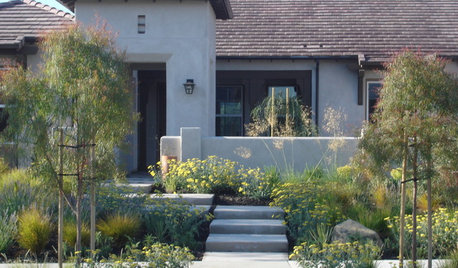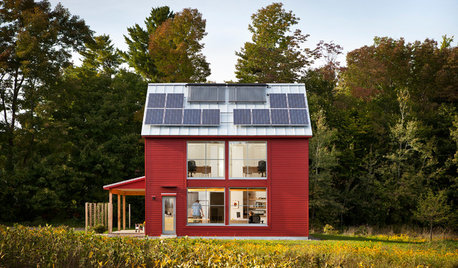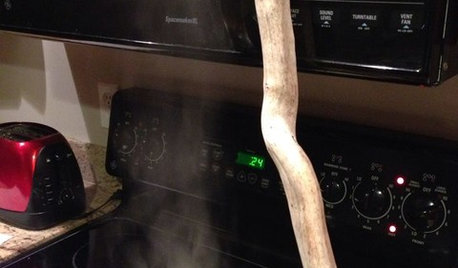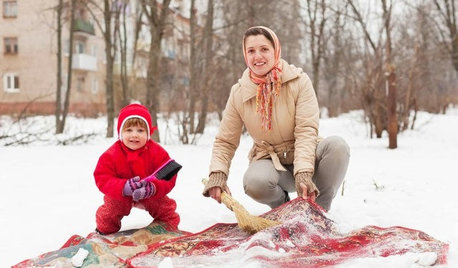March 2017 Planting/Conversation Thread
Okiedawn OK Zone 7
7 years ago
Featured Answer
Comments (394)
Melissa
7 years agohazelinok
7 years agoRelated Discussions
February 2017 Planting/Conversation Thread
Comments (286)Hazel, It has been a good week to be productive. I've been spending as much time as possible in the garden and have the aches and pains to prove it. My body always objects when I switch over from indoor winter laziness to outdoor hard labor. This week I'm paying the price for abandoning the garden last summer/fall to work on the kitchen remodel. All around the edges of the garden, persistent pain-in-the-neck plants crept into the garden despite the heavy mulch, so I've been digging out lots of bermuda and Johnson grass. It takes forever, but I'm determined to dig up all I can find and get it out of there before it can make headway and take back more garden space. I'm about 2/3rds of the way through the front garden and ought to have it back under full control in another week. Then I'll tackle the back garden. I guess digging out weedy grasses is a good way to kill time when most of the cool-season plants and seeds already are planted and it is still too cold to plant the warm-season ones. I am going to buy heavy clear plastic to solarize the area east of the garden where I want to expand it to make up for the northern and western areas that are getting too shady. I'd rather solarize for the entire warm growing season than rototill and dig out roots and go through all that this Spring. It is awful clay there which is why we haven't expanded eastward before now, and I'm dreading all the work it will take to turn it into good soil, but we started out with bad soil in 1999 and have made a lot of progress with the soil since then, so now we'll just start over with that process in a new area. Nancy, The worms will come. We had precious few in our early years but just kept working on the soil, and before we knew it, we had earthworms everywhere. This year there's a huge number of them. I don't know if there's more than usual, or if they are just more active earlier than usual since it has been so warm overall. When I want to attract earthworms to a new garden plot, I just put down cardboard and pile mulch over it. Earthworms love to eat cardboard and turn it into worm castings, so worms always show up soon after cardboard. I don't even know how they find it and know it is there, but they do. I love hugelkultur as a concept. It improves soil like nothing else. Many hugelkultur piles are built high above the ground in order to allow for the fact that the wood will rot and the level of the bed will fall. That is one thing I can't do because if the hugelkultur material is above ground in a mound-like shape, the rodents and snakes move in. I guess that is one of the hazards of living so close to the wild land alongside the Red River---wildlife is too abundant. So, when I build hugelkultur beds, I dig out a trench and bury 100% of the hugelkultur material. It means I have to keep adding more compostable material on top of the beds as the wood rots, but I don't care. I just pile on the mulch really thick and deep and let it decompose in place. We have a great many timber rattlers here (and their venom is very, very bad) and they come out of the woods and head for the garden, so I have to be careful that I'm not creating anything that makes the garden more attractive to them than it already is. While we also have plenty of copperheads, diamondback rattlers and pygmy rattlers, it is the timber rattlers that are the worst garden problem, followed by the copperheads. Generally I only see diamondback rattlers along the creek banks and pygmy rattlers in the woods. Water moccasins aren't a problem around the house ever since we removed the lily pond after the water moccasins moved to it in drought when the ponds and creeks dried up. I miss my lily pond, but having water moccasins in it eating the frogs made it too much of a hazard to keep. Sometimes I think about how much easier gardening would be if we lived in more of a city area where the wildlife is not so abundant, but I do love living in the country and never intend to leave. I just have to be a lot more careful. All my friends here are amazed I've never been bitten by a venomous snake considering how much time I spend outdoors and how many snakes we have here. I am grateful it hasn't happened yet, and won't be shocked if my luck runs out one day. I know how many close calls I've had, and I, too, am amazed that a snake hasn't bitten me yet. There's been at least two occasions when I was so close to a venomous snake that I can't even explain why I didn't get bitten, but I'm thankful it didn't happen. I'd build tons of hugelkultur mounds everywhere if I didn't have to worry about snakes crawling into their nooks and crannies. As it is, I have snakes in the compost piles all the time, so my actual compost piles never get turned once in the warm season because I don't want to stir up the snakes. I don't even want to see the snakes, and I'm careful to only load/unload compost nowadays with a compost scoop or shovel. I used to wear leather gloves and use my hands to lift compost from the wheelbarrow and drop it onto garden beds, but picking up a snake (non-venomous, but still.....) one day broke me of that habit. Most people here in my area (and by most, I guess I mean everyone but us) piles up brush and downed trees and burn them. We don't. We just find a place on the edge of the woods far from the house and make huge brush piles as if we were going to burn them, and then we never burn. We just let them sit there and decompose. I've done the same thing to fill in eroded areas where rain runoff has cut ravines and gullies. I just fill them in with brush and let it decompose in place. Add more to that year after year and the materials decompose and fill in the eroded areas gradually and then plants grow in the enriched soil and you stop the runoff from carrying off topsoil. It is a long, slow process, but we have healed a lot of badly eroded areas that way. It is sort of like building a hugelkultur for Mother Nature. After enough of the woody material breaks down, you end up with nice rich soil that supports native plants. Long before you even get the growth of the new plants, the piles of brush themselves hold the soil in place and stop the soil erosion almost right away. I'd rather be outside working than inside any and every day of the week. For a very long time, Tim worked evenings so I didn't even have to stop working outside until dark since I was the only one home. I was happy if dinner was just a bowl of cereal or a cold sandwich. Eventually he moved to day shift and I had to adjust to having someone coming home at night and expecting an actual home-cooked meal each night. It was really, really hard for me to drag myself into the house before dark, but I learned ways to work around it---the slow cooker, for instance, or cooking only every other day and making enough dinner to last two days, even though Tim is not a huge fan of leftovers. He still works days now and is unlikely ever to work nights again, but his workday is much longer, it seems, since his last promotion, so I still can work outdoors until almost dark, at least at this time of the year and still make it inside and cook dinner before he arrives home well after dark. During the height of the canning season, I generally don't stop canning just to cook dinner though. Either he brings home dinner or we eat leftovers or something that is easy to microwave. Usually after a long day of canning I am too hot and too tired to eat anything anyway, and he knows that and respects that because he does understand the amount of work that goes on in the kitchen during a full day of canning. The one things that having venomous snakes will do for you is that it will train you to get out of the garden and get the garden gate closed and latched before the snakes come out in the evenings. Our snakes use the gravel driveway like a snake highway and I need to be out of the driveway before they come out. I don't want to walk up the driveway to the house in the dark for sure. Some of my scariest snake encounters have been right there in the driveway, especially near the garden gate. It sort of makes me laugh to think that the snakes use the entrance gate area if they can, but it is true. We have 1" chicken wire fencing attached to the lower 2' of the garden's woven wire fencing in order to keep out the baby bunnies, and the snakes sometimes get hung up in that chicken wire, so they prefer to enter/exit through the gate area. Kim, I saw a news story on Facebook about the Tulia fire. My niece, who lives near Abilene, linked the story so of course I had to click on the story and read it. What an awful fire that was! It has been a long time since we've had a fire that large here and I'm grateful for that. Even though we're greening up early here, we haven't greened up enough yet to significantly lower the fire risk. At least a couple of fire departments are out daily fighting fires, but we haven't had a fire ourselves since last Saturday when we had a string of fires along I-35 that briefly threatened at least one home....and made a lot of people really nervous for an hour or two. I've been enjoying the quiet week and getting a lot done, but don't expect the quiet spell will last. I'm glad your greenhouse held up in the wind. With a new greenhouse, you never know at first how it is going to do in wind until you actually have that strong wind occur, so it is good that it seems like it can tolerate your west Texas wind. I've never yet seen a greenhouse here go airborne, but with some of the small ones that aren't anchored to the ground, I imagine it probably could happen. Dawn...See MoreMarch 2017 Blooms
Comments (91)Weird. Neohenricia sibbettii blooms are supposed to be scented but mine is odorless! The S. niveum has a faint smell of syrupy gardenia. It may also because there were two of them open at the same time so there was enough molecules for my brain to register. Bottlebrush, eh. More like lens brush?...See MoreApril Planting/Conversation Thread
Comments (241)Meanwhile, we also have a banner crop of little elm seedlings out there, as well as the little oaks I'd previously mentioned. My prayer is that the voles like little elm seedling and oak seedling roots to keep them busy until I can figure out how to destroy them. . . I noted your comment, Dawn, about how often when oaks have a banner year, the voles appear. And I have researched and figure we have pine voles, which are typical for this area, and are mostly subterranean.. . which is what my observation has been. On with the battle tomorrow. . . mouse traps, ordering one bait station (pet impervious) and ammo, my continued use of castor pellets and my liquid garlic and cayenne. A multi-pronged attack, one could say--plus the call to exterminators. I saw some vole holes in my two nearby gardener neighbors' yards and pointed them out to them--neither had heard of voles--but nothing like what we've got. When one of them visited me last week, I showed her the holes in my front yard and she too was horrified. Can you all tell I'm a little preoccupied with voles right now? Sorry about that. Amy (and Rebecca, and anyone else who lives nearby--we're in Whitehorn Cove outside of Wagoner--it should be a town itself-- it would be terrific to get together. Tahlequa would be a fun destination, such a pretty drive. Driving to our "grandkids" near Bixby is also a lovely drive, and if we take a shortcut (which we always do now, now that we know where it is), we get lots of fun steep hills (bet they're hell in an ice storm), and there's a winery we pass. . . looking good this spring. . . the grapes are a growin'. We took off fishing this morning kind of the spur of the moment deal. About 8:30, I said to GDW, if we don't go fishing today, we won't be going until next week. Today looks better than tomorrow (he loves fishing SO much, but doesn't say much. I like fishing, but would gladly give it up to stay home and garden. In fact, actually hate fishing during spring gardening. There, I said it.) So off we went, and I know I made him very happy by being the first to bring it up. . . and it's so important to me to make him happy, because he is the best, and because I am happier than I have ever been in my entire life since we reconnected. And we had an absolute blast! We laughed, and laughed and laughed. And those big spoonblll led us a merry chase today. He lost 3, I lost one. . . of course the ones we lost were the smarter bigger ones who came out victorious, before I caught my one and he caught his one. . . by that time we truly were exhausted. And neither of the ones we caught were wounded at all badly--he caught his by the tail, and I caught mine by the edge of its bill, so we scolded them to be more careful next time and let em go. Mine was pretty small, about 20 lbs, and his was quite large, probably about 45-50 lbs. Having said that, if cleaned properly, they are REALLY good-tasting fish. A lot like sea bass--not fishy tasting, and very dense meat--like a very tender sea bass "steak." Ahh, parrots and parakeets. . . I adore them. There's a great book/movie, can't remember it at the moment a parrot as one of the main characters. . . South American. Someone? Our nearby neighbor has a parrot, a real character, who is very funny. I had parakeets for 20 years, and adored them, and they me. Love love birds. And love parakeets. Which reminds me--what is the beautiful butterfly that is kind of black and blue? We have several of them right now. Okay. . . I think I'm winding down now. What a joyful gift we gardeners have, and to be able to enjoy it with those who have it too, is a true blessing....See MoreWeek 2, May 2017, General Thread
Comments (135)I started the new Week 3 thread for this week, but had to come here to the Week 2 thread to catch up on everything I missed yesterday. Amy, That is too funny about blondes....and so true. I'm really bad about hurting myself with very sharp tools, so I have to make a conscious effort to remember to be careful when handling them. I almost cut off a finger once with some really sharp loping shears, and the only stitches I've ever had to get in my life followed an accident in the garden caused by my own klutizness. I don't seem to be getting any less accident-prone as I get older either. Kim, Congrats on the shed! I know it will be a big time saver. I have a shed, but have stedfastly refused to use it the last couple of years. A neighbor tore down a very old country home (unoccupied for decades) on their property a few years ago and apparently the wild things that had been living in it moved into my potting shed. After too many rat and snake encounters, I fled from the shed and it sits there unused. It is about 25 years old and is falling apart, so we're planning to build a new one this summer or autumn and we will build it as rodent-proof and as snake-proof as possible. I loved my shed, but it is old and rickety, it leaks and it has places where critters can get in...even after you've found those spots, patched them and think you've solved the problem. I hope your shed is in better shape than mine. I'm looking forward to building the new one because I do get tired of lugging tools back and forth. About 6 weeks ago we bought one of those brown plastic deck storage boxes that are meant to sit on your deck and hold stuff. Mine now sits in the garden and holds tools and stuff, but since our two fenced garden areas are about 300' apart, it never fails that I continue to lug tools back and forth from one garden to the other even if they spend their storage time at night in the deck box. Still, I'd rather have it than not have it. I totally and completely agree with you about the onion harvest photos on FB. I am totally appalled every time someone posts photos of their onion harvest and the onions don't even have soft necks yet! I just bite my tongue and don't say anything because I don't want to offend them by asking, in a horrified tone, "Are you pulling them half-grown on purpose?" I suspect they have no idea they are harvesting too early, and maybe someone ought to tell them that they are, but I don't want to embarass anyone either. I figure we can wait until they complain that their onions are either rotting or sprouting very quickly, and then we can tell them that they harvested too early. They'll learn from that experience anyway. I'm seeing the same thing with potatoes. Some folks are harvesting pretty small potatoes and I cannot help thinking that if they'd wait a bit longer, they'd have a lot larger harvest. And, of course, some of us have plenty of space and can let our onions and potatoes fully mature, but other folks are incredibly space challenged and may be harvesting early on purpose so that they can put in a succession crop. That's certainly an option when one has limited gardening space. What was going on with the tomato plant you pulled? Did it look like one of the common fungal or bacterial things we tend to see as the hot weather is arriving, or did it look worse....maybe like Tomato Spotted Wilt? The heat was dreadful yesterday. It hit 90 degrees here, so I imagine it was even worse at your place. I'm not really ready for it, but it is here. Hopefully the rain in the forecast for later in the week won't miss us again. We sure could use the rainfall, and the cooler air temperatures would be a nice break from the 90s. I'm never happy when the 90s show up in mid-May.....don't they know they we are supposed to stay in the 80s in May? June is soon enough for the 90s. Rebecca, In the years when I have grown moonflowers, I've always grown them in full sun, even in full sun in very bad soil in drought in our earliest years here, and they did just fine. They won't bloom until late July or early August, but once they start blooming, you'll want to run outdoors at the right time every evening so you can watch the big white flowers unfurl virtually in unison. It is the most amazing thing. I've seen it hundreds of times and never tire of watching it. When I grow moonflowers and morning glories together in the same area, the moonflower vines tend to aggressively outgrow the morning glory vines (which really says something because morning glories are pretty aggressive themselves), so I usually grow the moon flowers on one garden fence (the southern fenceline) and the morning glories on the eastern fence line, which faces the road. A fence covered with Heavenly Blue morning glories in bloom with stop traffic in the summer time, or people see the morning glories, honk their horn and wave as they go by or give the morning glories and I a thumbs up. I vary the fence-climbing flowers from year to year so that I don't get stuck in a rut. This year, I've pulled all the morning glory volunteers that sprout (which is a lot) and planted moonflowers along the fenceline after we put up the new fence on the southern edge of the garden. I feel bad about weeding out all the morning glories, but I want a solid wall of moonflowers on the new fence. I'm toying with planting either Grandpa Ott's or Heavenly Blue morning glories along the eastern fence line. I'd rather grow southern peas on that fence line, and that has been my plan all along, but I could grow the Red Ripper and Yellow Ripper peas on the northern fence line and let the eastern fence have some pretty flowers. I need to make a decision this week and get them all planted somewhere. I've been waiting for rain, and I think this week we might actually finally get some rainfall down here. Our typical May rainfall is a little over 5", and our official rainfall for May so far is 0.38". All the green is shading towards brown already. Squash bugs are there already, Hazel, because they likely overwintered in some sort of garden debris---mulch, a brush pile, a nearby woodland, a compost pile, etc. The only way to keep them from establishing a permanent population on your property is to kill every single one you see. I spend an inordinate amount of time trying to find and kill them all every summer, but it is essential. If you kill them all, they won't show up as early the next year because they'll have to migrate in from elsewhere. The further away other gardens and/or farms that grow cucurbits are from you and your garden, the later in summer it will be when the squash bugs show up. May is usually when they do show up, so I'm not surprised you're seeing them. I'm kinda surprised I haven't seen any yet, but I am not complaining. I do check the plants for them daily as my only chance of controlling them is to go all ballistic and kill, kill, kill them from the first moment I see them. Nothing gives me more pleasure than finding squash bug eggs and destroying them before they even hatch because that's just that many fewer bugs to deal with later on. Congrats on the SunGolds! Aren't they the best? Once you taste fully ripened SunGolds it is easy to understand why their flavor is legendary. Nancy, I'm surprised that morning glories and moonflower vines don't handle full sun there. They tolerate it here, even tolerating high temperatures as high as 110-112 as long as the plants are well-watered and well-mulched. Perhaps it is your humidity there. Normally, we are dry in summer in our county, so high humidity and the diseases that often accompany it are not an issue here in summer. I've never grown moonflower vines or morning glories in part shade, largely because until recent years, we haven't had shade except at the west end of the garden.....and I don't want to make the shade problem worse by growing vines on the west fence. As long as the tomatoes you're growing are not the green-when-ripe type, you'll find them as they mature because their colors will become more apparent as they ripen. When dense foliage can make it hard to find green tomatoes, I don't care. I know the green tomatoes are there even if I don't see them all, and the foliage keeps our wickedly intense sunlight from sunscalding the fruit. Even with the green-when-ripe varieties, they don't stay solid green as they mature. Most of them develop an amber or yellow color on a least a portion of the fruit, so they're not as hard to spot as one would think they might be. I grow as much as possible in full sun, and am working to keep the shade out of my garden....if moonflowers and morning glories couldn't tolerate full sun in our climate, I wouldn't even grow them. They love it. If y'all are having trouble with them in full sun, it likely is not the heat or the light---it is the humidity and the plant diseases that accompany high humidity. Dawn...See MoreNancy RW (zone 7)
7 years agojlhart76
7 years agoOkiedawn OK Zone 7
7 years agoAmyinOwasso/zone 6b
7 years agoOkiedawn OK Zone 7
7 years agoluvncannin
7 years agochickencoupe
7 years agoNancy RW (zone 7)
7 years agohazelinok
7 years agoAmyinOwasso/zone 6b
7 years agoNancy RW (zone 7)
7 years agoMelissa
7 years agoNancy RW (zone 7)
7 years agoluvncannin
7 years agoMelissa
7 years agoNancy RW (zone 7)
7 years agoNancy RW (zone 7)
7 years agoNancy RW (zone 7)
7 years agoNancy RW (zone 7)
7 years agoNancy RW (zone 7)
7 years agoNancy RW (zone 7)
7 years agoOkiedawn OK Zone 7
7 years agoNancy RW (zone 7)
7 years agohazelinok
7 years agolast modified: 7 years agobaabaamilker
7 years agoOkiedawn OK Zone 7
7 years agohazelinok
7 years agolast modified: 7 years agoluvncannin
7 years agoNancy RW (zone 7)
7 years agoNancy RW (zone 7)
7 years agoAmyinOwasso/zone 6b
7 years agoluvncannin
7 years agohazelinok
7 years agochickencoupe
7 years agoRebecca (7a)
7 years agobaabaamilker
7 years agoAmyinOwasso/zone 6b
7 years agoKatie Jbaugh
7 years agoKatie Jbaugh
7 years agoOkiedawn OK Zone 7
7 years agoAmyinOwasso/zone 6b
7 years agoAmyinOwasso/zone 6b
7 years agoRebecca (7a)
7 years agohazelinok
7 years agoNancy RW (zone 7)
7 years agoOkiedawn OK Zone 7
7 years agoNancy RW (zone 7)
7 years agoOkiedawn OK Zone 7
7 years ago
Related Stories

LANDSCAPE DESIGNGet Along With Less Lawn — Ideas to Save Water and Effort
Ditch the mower and lower your water bill while creating a feast for the eyes with diverse plantings and gathering places
Full Story
GARDENING AND LANDSCAPINGGrow a Lush Privacy Screen
No need to wait forever for patio privacy the green way. These 10 ideas will get your screening up and running in no time
Full Story
LIFEThat’s a Talker: 10 Stories You Had Lots to Say About This Year
The world’s ugliest color, tubs vs. showers, and TVs over fireplaces had readers talking in 2016. Tell us what you think
Full Story
GREEN BUILDINGGoing Solar at Home: Solar Panel Basics
Save money on electricity and reduce your carbon footprint by installing photovoltaic panels. This guide will help you get started
Full Story
LIFEHouzz Call: Show Us Your Nutty Home Fixes
If you've masterminded a solution — silly or ingenious — to a home issue, we want to know
Full Story
HOUSEKEEPINGWhat's That Sound? 9 Home Noises and How to Fix Them
Bumps and thumps might be driving you crazy, but they also might mean big trouble. We give you the lowdown and which pro to call for help
Full Story
HOMES AROUND THE WORLDHousehold Habits and Customs to Borrow From Other Countries
Discover why salt may be the perfect house-warming gift, how to clean rugs in snow and why you should invest in a pair of ‘toilet slippers’
Full Story
GREEN BUILDINGWhy You Might Want to Build a House of Straw
Straw bales are cheap, easy to find and DIY-friendly. Get the basics on building with this renewable, ecofriendly material
Full Story
MIDCENTURY HOMESHouzz Tour: Pools and Martinis Inspire a Palm Springs Remodel
Weighed down by black-heavy ’80s style, a California desert home gets a fun and lighthearted look just right for its midcentury roots
Full Story
COLORDecorating 101: How to Choose Your Colors
Learn where to look for palette inspiration — and one commonly advised place maybe you shouldn’t
Full Story









Okiedawn OK Zone 7Original Author